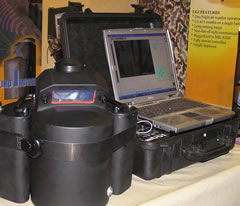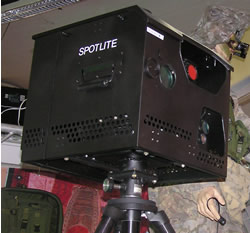While radars and IR scanners are effective for open area surveillance, urban combat poses distinct environmental challenges for troop protection. Special sensors are designed for such applications. For example, sensors are required to trigger an alarm when movement is detected inside a specific building or room, which could otherwise be considered as “clean”. Other sensors are designed to “look through walls” and identify human presence, movement beyond etc.
Ground sensors designed for urban operations are usually multi-sensor packages; their communications are designed to overcome the obstacles and multi-path reflections of urban terrain, and camouflaged to mimic common urban terrain features. An example is the Miniature Unattended Ground Imager (MUGI), developed by Seraphim. It provides covert, persistent visual surveillance of a target using periscopic EO, NIR and IR imaging devices, fitted with internal pan, tilt and zoom, As the device has no external movement the system can blend into the surrounding scene for covert operation. The device can remain in the field, delivering up to 10 days of imaging without battery replacement. BAE Systems has integrated a collection of four types of sensors for the US Army including Moving Target Indicator (MTI) Radar, Magnetic, Seismic, and Single Pixel IR packed into an integrated sensor unit. The unit will monitor its surrounding area and send reports to the user’s pager, PDA, or laptop PC. The different sensors are selected to match the specific environment. For example, where radar is blocked by metal siding, seismic and magnetic sensors can provide comparable coverage. The seismic sensor can also be highly effective to identify footsteps in a wood frame building but though unable to provide a direction or distance of such movement. The single pixel IR can localize the direction of a human if there is no blockage. By deploying different types of sensors, virtually uninterrupted coverage can be obtained.
Sniper Detectors
 Other sensors are used to identify fire sources to facilitate quick and effective response. Such systems utilize both acoustic and EO sensors. These systems measure azimuth, elevation and distance of a sniper or small arms firing source. An example is the Viper Counter-Sniper System, developed in the mid 1990s for the US Naval Research Lab for counter-sniper activity. Viper is comprised of an infrared camera automatically detecting muzzle flash signature distinctive of small arms fire. A television camera with high power zoom provides target identification, and fire control. The system can be integrated with remotely controlled counterfire payload, which can mount lethal or less lethal means. Viper can be employed on fixed sites or in a vehicular installation. The system detects rifle fire within seventy milliseconds of its occurrence, during this time a supersonic bullet would travel less than 50 meters. A different system developed by RAFAEL is the Spotlite – a high precision, IR sensor capable of detection of small arms fire sources. The system detects multiple small arms/sniper fire sources simultaneously, day and night, at long distances. Spotlite analyzes the fire sources detected, verifying that it is actually enemy fire. Once verified, target parameters (type, location, elevation etc) are transferred to snipers and other weapon systems, thereby closing the sensor-to-shooter loop quickly and efficiently. Similar camera-based systems such as the Pivot system are integrating a camera and an acoustic detector (Pilar).
Other sensors are used to identify fire sources to facilitate quick and effective response. Such systems utilize both acoustic and EO sensors. These systems measure azimuth, elevation and distance of a sniper or small arms firing source. An example is the Viper Counter-Sniper System, developed in the mid 1990s for the US Naval Research Lab for counter-sniper activity. Viper is comprised of an infrared camera automatically detecting muzzle flash signature distinctive of small arms fire. A television camera with high power zoom provides target identification, and fire control. The system can be integrated with remotely controlled counterfire payload, which can mount lethal or less lethal means. Viper can be employed on fixed sites or in a vehicular installation. The system detects rifle fire within seventy milliseconds of its occurrence, during this time a supersonic bullet would travel less than 50 meters. A different system developed by RAFAEL is the Spotlite – a high precision, IR sensor capable of detection of small arms fire sources. The system detects multiple small arms/sniper fire sources simultaneously, day and night, at long distances. Spotlite analyzes the fire sources detected, verifying that it is actually enemy fire. Once verified, target parameters (type, location, elevation etc) are transferred to snipers and other weapon systems, thereby closing the sensor-to-shooter loop quickly and efficiently. Similar camera-based systems such as the Pivot system are integrating a camera and an acoustic detector (Pilar).
Additional parts of this article:
















